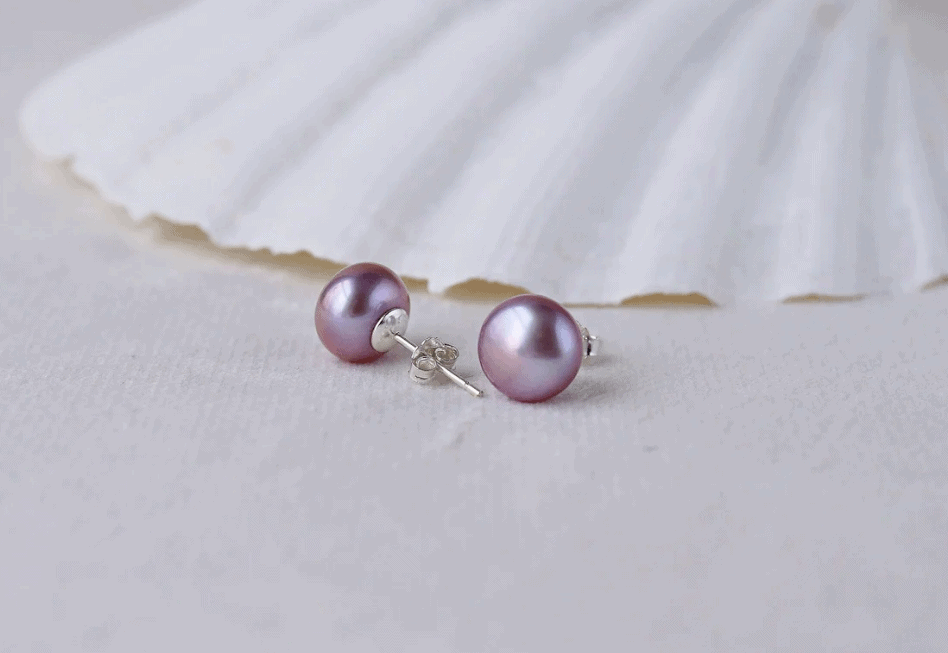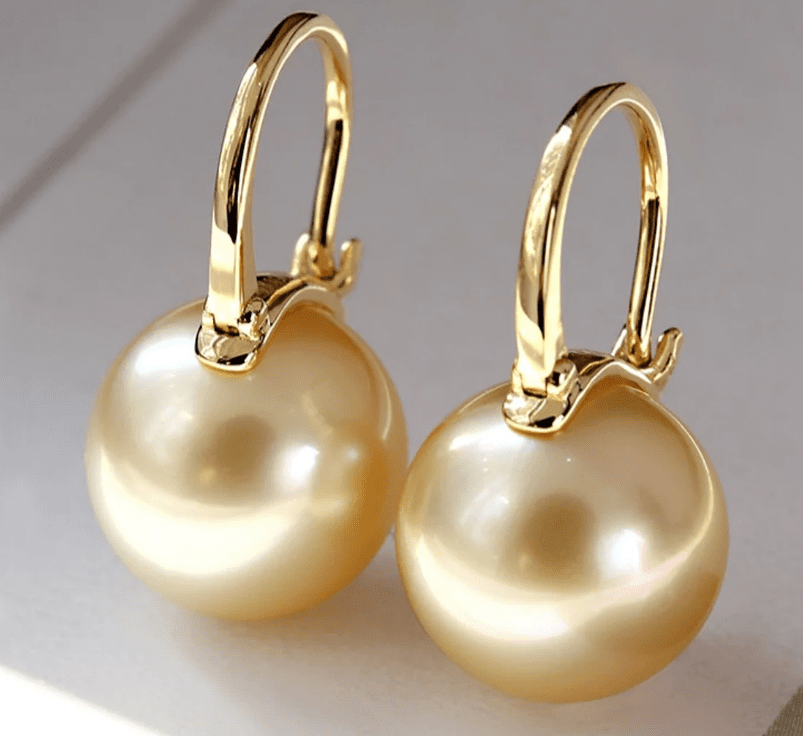
Table of Contents
When we say pearls, we tend to think of beautiful milky white spheres. In fact, the very word ‘pearl’ is synonymous with the color white. This image is so firmly entrenched in our minds that many people are surprised to learn that there pearls in other colors as well.
Pearls occur in a variety of body and overtone colors, with some of these colors being very pricey and highly sought after. While white pearls are the quintessential and traditional pearl color, colored pearls spice up your jewelry collection and add a new and unconventional look.
Let’s take a look at all the different colors of pearls there are and which is the best for you.
Natural Pearl Colors

Pearls, whether saltwater or freshwater, come in a range of colors. The most common color for pearls is white, cream or gray, but they also come in colors such as purple, black, pink, green, champagne, chocolate, blue and lavender. Some pearls have stunning overtones that exhibit multi-colors.
Although humans now successfully culture pearls and create them in controlled environments, there are still certain aspects of the process that they have little control over. One such aspect is the color of the pearl. While there are some ways to influence this, most times this is simply left to chance. The organic nature in which the pearl is created means that there are many factors that can influence the color of the pearl.
Here are some of the aspects that can affect the color of a pearl:
Type of Mollusk
Pearl colors are mainly influenced by the color of the mollusks lip, which refers to the outer part of the shell. For example, the famous black Tahitian pearls come from the Pinctada margaritifera oyster, which has gray and silver tints at the outer edges of its shell. This is the only mollusk that can form natural black pearls. Another popular variety is the silver lipped oyster (Pinctada maxima) which is known for creating the luxurious South Sea pearl variety.
Thickness of Nacre
Just in case you were wondering, the nacre refers to the substance that the mollusk uses to layer the irritant placed within it. Over time, this grows into the pearl. In general, the thicker the nacre, the deeper and richer the color of the pearl. The thickness of the nacre also affects the pearl’s iridescence, with thin nacre usually creating milky pearls with little to no overtone.
Human Interference
Sometimes, pearl manufacturers can influence the color of the pearl by using various culturing techniques. One main way is to include tissue from an additional oyster into the host oyster as well as the nucleus.
Dyeing the Pearl
Dyeing the pearl is another way to change the color of the gemstone. For example, any black pearl you see on the market that is not a Tahitian pearl, has been dyed. This includes black Akoya pearls.
Related Article: The Best Place to Buy Pearls Online (USA)
Rare Pearl Colors

The most common pearl colors are white to gray, with pink, silver and green overtones. Black pearls are also relatively abundant and can be easily found on the market. However, most of the colored pearls are very rare and it can be difficult to find natural ones.
Pink pearls are highly prized, especially in the United States, but are among the rarest natural pearl colors. These are created by the endangered queen conch snail and as yet have not been successfully cultured. As a result, most pink pearls on the market are dyed freshwater pearls.
Another rare and very pricey type of pearl is the Golden south sea. These are created by the gold lipped oyster and are only found in certain parts of the world.
Natural Blue Akoya pearls are also extremely rare. Although in the past they were seen as pariahs of the pearl industry, due to their different color and often irregular shape, they are now highly coveted.
Pearl Color and Value
Pearl color has a major impact on cost, although there are other factors to consider as well, such as size, type, quality, shape and luster. If a pearl color is uniform and even, it adds to the value of the stone. Deep body tones with beautiful overtone colors are more expensive than duller stones.
So what are the most expensive pearl colors?
In general, pearls with different colors such as gold, pink and blue are more expensive, due to their rarity.
Black pearls used to be extremely expensive, but they are now more affordable since they have begun to be cultured. While white pearls are generally less expensive than colored varieties, a natural white pearl would be more expensive than cultured colored pearls. Currently, the most expensive pearls that are commonly found on the market are the South Sea variety, which occurs primarily in white and gold colors.
Pearl Color Meaning
Pearls are among the oldest used gemstones in jewelry and like all gemstones, has acquired symbolism and meaning over time. If you aren’t sure which pearl color to choose, perhaps the symbolism of the piece can be a reason.
1. White Pearls

White pearls have always been a favorite when it comes to wedding jewelry. It is easy to see why as the symbolism and appearance of these stones are ideal for a new bride. They are a symbol of innocence, purity and beauty. White also symbolizes peace and sincerity.
2. Black Pearls

Black pearls are intriguing, mysterious and eye-catching. They are a break from tradition and are the quintessential unconventional gemstone. Black pearls demonstrate independence, strength, sophistication, unconventionality and a bold step out of the norm.
3. Pink Pearls
Pink is a very feminine color, with pink pearls or pearls with strong pink overtones representing romance, femininity and softness. They are also very rare so finding a beautiful pink pearl is a steal!
4. Purple Pearls

Purple as a color represents nobility, royalty, prestige and class. It is also a symbol of education, wisdom and creativity. Purple pearls also have a feminine touch and an aura of sophistication. Because it is a very rare pearl color, a purple pearl is always eye-catching.
5. Blue Pearls
Blue is one of the most popular colors for gemstones and represents calmness, serenity, truth and courage, among other things. Blue pearls are very rare and have a beautiful iridescence about them. They are generally thought perfect for a person going through a tough time and who needs courage and strength.
6. Gold Pearls

Gold is synonymous with wealth, class and prosperity. It is not for nothing that gold pearls are among the most expensive! They are the ideal way to demonstrate class, prestige and a touch of sophistication!
7. Brown Pearls
Often called chocolate pearls, brown pearls are a steady and enduring color. Brown pearls represent dependability, stability and harmony.
Pearl Color Enhancements

Almost all pearls on the market, whether freshwater or saltwater, are subjected to some form of treatment to enhance the color and appearance. Here are some treatments that are done on pearls:
Dyeing Pearls
Pearls are sometimes dyed to obtain beautiful and rare colors that customers seek. These include black and gold, to mimic the appearance of Tahitian and Golden south sea pearls. Pearl manufacturers often dye pearls to satisfy the requirements of certain markets. For example, in the US, Americans prefer pearls that have pink overtones, Indians prefer cream colored pearls while Germans go for white pearls. To supply for these markets, pearl farmers often dye their pearls.
Polishing and Bleaching Pearls
Once pearls have been extracted, they are often polished in a saline solution and then bleached to achieve a perfect white color. This treatment is quite common in the industry, especially in relation to South Sea pearls.
Irradiating Pearls
This a method where gamma rays are used to influence the color of pearls and has different effects on saltwater and freshwater pearls. This technique is used in Akoya saltwater pearls to darken the nucleus of the pearl, thus creating a more unique and valuable pearl color. With freshwater pearls, the gamma rays are used to darken the layers of nacre of the pearl. Irradiating pearls can also cause a beautiful, metallic shine to appear over the surface of freshwater pearls.
Pearl Pinking
This is done through a dying process that gives the pearl a pinkish overtone. Because pink pearls, or pearls with pink overtones, are highly sought after, pearl cultivators keep up with the demand in this way.
Pearl treatments to enhance color are common and generally accepted in cultured pearls. However, ensure that the pearl is priced accordingly and that there is transparency from the retailer.
Which Pearl Color Should I Choose?
The pearl color you choose largely depends on your budget and preferences. You may also wish to consider your skin tone as a factor that influences your decision. Certain pearl colors look stunning against certain skin tones and can be very flattering.
In general, white and cream colored pearls go well with all skin tones and have a classic, traditional look. These are very elegant and sophisticated in appearance. There are also modern chic and trendy types of pearl jewelry that add a twist to the notion that pearls are traditional.
For a look that’s off the beaten path, try adding colored pearls to your collection, such as Tahitian or Golden South Sea pearls. These really jazz up your look, are eye-catching and unique.









